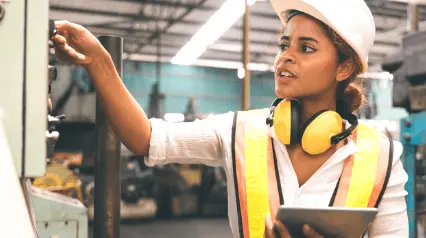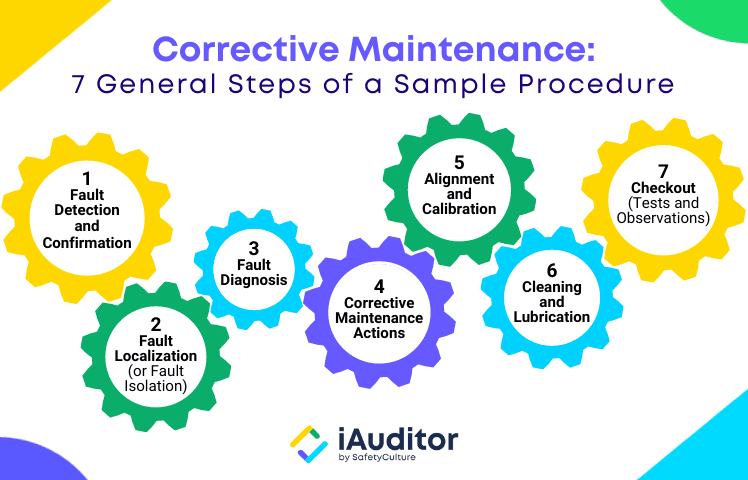What is Corrective Maintenance?
Corrective maintenance (CM) is a type of maintenance done by technicians to correct a malfunction of equipment, machinery, and systems so that they can be restored to good working condition. It also aims to bring company assets back to specified performance levels. Corrective maintenance is sometimes called reactive maintenance because it is triggered when a machine failure has already happened.
Corrective Maintenance vs Preventive Maintenance
Generally, the difference between corrective maintenance and preventive maintenance is the timeframe at which each of them is carried out. Corrective maintenance is a type of maintenance commonly performed after equipment breakdown, while preventive maintenance is periodically performed to anticipate and mitigate the risk of unplanned downtime.
To further compare the difference between corrective and preventive maintenance, refer to the following table:
Corrective Maintenance |
Preventive Maintenance |
|
Main Purpose |
For restoring machine operability | For continuous system operation |
Nature of Task |
Unplanned and Unscheduled | Planned and Scheduled |
Frequency |
Every time equipment breaks down | Regularly conducted at a set time |
General Protocol |
Implement repairs: part replacement, reassembly, adjustment, and testing | Perform inspections: impending failure detection and prevention |
Types of Corrective Maintenance with Examples
Corrective maintenance is usually categorized into two types: breakdown maintenance and deferred maintenance. Listed below are the definitions of each corrective maintenance type along with real-world examples:
Breakdown Maintenance
Breakdown maintenance, also known as emergency maintenance, is a type of corrective maintenance urgently carried out upon machine failure in order to resume critical business processes. For example, an electric company instantly fixes or replaces a blown transformer in its distribution system.
Deferred Maintenance
Deferred maintenance, or deferred corrective maintenance, is a type of corrective maintenance often postponed due to inadequate resources such as finances, supplies, and manpower. For example, building management might delay repairing HVAC or air-conditioning units because of a lack of budget.
4 Actions
According to the U.S. Army Engineering Design Handbook: Maintenance Engineering Techniques, there are corrective maintenance tasks that can be done aside from repairs of a specific malfunction or replacement of a serviceable component. The following are 4 corrective maintenance activities based on the handbook:
- Overhaul: to restore an item to a satisfactory condition based on maintenance serviceability standards and the “inspect and repair only as necessary” technique
- Rebuild: to completely disassemble, inspect all parts, repair or replace worn elements, reassemble, and test a piece of equipment in order to restore it as close as possible to the original or new condition in appearance, performance, and life expectancy
- Salvage: to dispose materials that are not repairable or usable anymore and utilize salvaged materials from irreparable assets
- Servicing: to specifically fix or tune up components or subassemblies after executing a corrective action on machinery
How to Perform Corrective Maintenance
Corrective maintenance procedures vary per equipment, allocated resources, and company requirements, among other factors. For example, machines using modern technology can reduce the time it takes to diagnose a problem and lower the cost of repair while maintaining uptimes. Here is a general process of corrective maintenance steps to help managers and technicians get started:
Step 1: Be aware of a detected malfunction in the system
Once detected, machine failure must be confirmed by onsite technicians. If proven that there was no fault found, then the system is generally returned to service. However, if a malfunction is confirmed to have occurred, then corrective maintenance actions must be taken. Normally, a failure report must also be completed prior to carrying out corrective maintenance tasks.
Step 2: Localize the defect to a specific equipment within the system
Fault localization, sometimes referred to as fault isolation, is the process of determining the location of a fault to the extent necessary in order to effect repair. In the context of corrective maintenance, it is the act of pinpointing the defect to a specific equipment within the system. Technicians need to identify in which equipment in the entire system the fault actually took place.
Step 3: Diagnose the issue of a particular component within the equipment
Upon identifying exactly where the fault is, diagnosis of the defective part in the equipment happens next. Certain hardware, software, or other documented means are typically utilized to determine the cause of the malfunction. In most machines, a built-in-test capability with existing hardware and/or software components can help diagnose the problem of a faulty part.
Step 4: Repair or replace the faulty part or item in the equipment
In the corrective maintenance process, this is when technicians implement corrections such as repairing or replacing machine parts, among other corrective maintenance actions. This step can also be called “fault correction”, where maintenance tasks are carried out to rectify the malfunction. Basic measures of maintainability like the mean-time-to-repair, or corrective maintenance time, often encompasses this step.
Step 5: Align and calibrate the repaired or new part in relation to the system
After correcting the faulty item, alignment and calibration usually follows which marks the beginning of checkout, or the series of tests on the item to determine its condition or status. It is crucial to perform the necessary adjustments when restoring any item to a specified operation. Moreover, a comparison of a measuring device with a set standard and a subsequent alignment must be applied in order to remove deviations.
For a more efficient performance of corrective actions, consider using specific tools for different tasks and activities. This can include devices such as safety management software to reduce safety risks and hazards in workplaces, inspection software to conduct assessments as needed, or as specific as excavation safety software for construction activities.
Step 6: Clean and lubricate the equipment accordingly
Following calibration, contamination control and lubrication commonly takes place to help keep the item in good operating condition. It is essential to use a clean lubricant in the right amount. Thorough cleaning of the equipment and its components not only can make it easier to discover potential issues and yield longer life, but it can also help achieve better reliability and lower costs.
Step 7: Validate performance before returning the system to service
Finally, tests must be made so that the performance of the item can be verified to have reached its specified condition. This step completes the checkout and the general sample of a corrective maintenance process. If the results reveal that the item in relation to the equipment works satisfactorily, then the system can be returned to service and business operations can resume.
Create Your Own Corrective Maintenance Checklist
Eliminate manual tasks and streamline your operations.
Get started for FREEHow SafetyCulture Can Help
While maintenance managers and technicians can only do so much in doing their duties, unplanned and unscheduled breakdowns may still arise. Respond to the unexpected at lightning speed and resolve issues with your team using a digital operations management platform like SafetyCulture (formerly iAuditor). SafetyCulture can help maintenance teams to:
Easily perform corrective maintenance tasks
Use corrective maintenance checklists on mobile devices such as smartphones, tablets, and iPads—even when offline. Checklists can easily be created using a drag-and-drop editor; pre-made industry templates downloaded from the SafetyCulture Public Library can also be customized. Upon completion of tasks, professional-looking reports are automatically generated and sent to designated personnel.
Report issues and keep track of corrective actions
Taking advantage of a real-time incident reporting capability, maintenance teams can raise issues with photo evidence and communicate within the mobile app. Corrective actions with priority level and due date can also be assigned to specific staff members as a solution to the issue. Be empowered to commence a probe at the onset and foster better collaboration among teams.
Cut Back on Organizational Spending with Corrective Maintenance Training
While many would say preventative maintenance should be at the top of your priority list, you shouldn’t slack on corrective maintenance. After all, errors and failures can happen at any time, and you and your team should always be prepared. That’s why it’s important to invest in corrective maintenance training.
Corrective maintenance training can help your workers restore broken-down machines or equipment to their normal operational state as much as possible. It teaches them the latest industry techniques and guidelines to help your assets get back into shape. When your workers are trained properly, this can help you cut back on organizational spending since you’ll avoid spending on newer and, more often, more expensive equipment.
The good news is that training doesn’t have to be a big investment of time or money anymore. With Training, you can transform your corrective maintenance instructions into interactive, bite-sized training that your maintenance staff can easily complete in minutes. These courses are readily accessible via their mobile devices, allowing them to receive the training they need whenever, wherever they are.
Visualize inspection data and analyze maintenance trends
All information gathered from corrective maintenance activities that used checklists are instantly organized in beautiful dashboards. Easy-to-use analytics features enable maintenance managers to spot trends such as the most commonly failed items or maintenance issues during corrective maintenance checks and more. Access analytics with SafetyCulture premium—start your 30-day free trial by signing up today!





